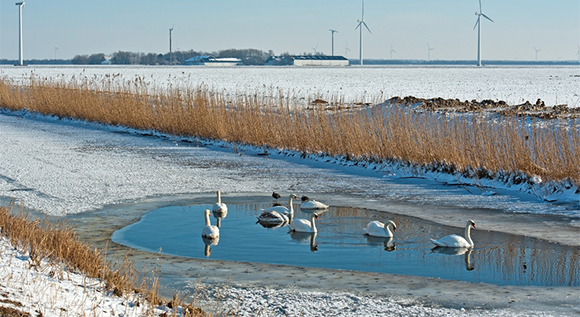Stopping the wind from stopping the turbines
When the rotor blades of wind-powered installations freeze over, they can turn into dangerous ice throwers. This is why legislation provides for these installations to be shut off in these conditions. Scientists are working on ways to prevent the need for a shutdown.
 © Adobe Stock/Naj
© Adobe Stock/Naj
Last year in Germany, more electricity was generated by wind-powered installations than by nuclear plants or hard coal or gas-fired power plants. Altogether, Germany’s on and offshore wind farms had an output of almost 105 terawatt hours – a figure that corresponds to more than 15 per cent of the country’s total electricity generation. In autumn and winter especially, when there is a great deal of wind and storm, wind-powered installations can generate as much as 80 per cent of Germany’s electricity consumption. However, there is a caveat: this only applies if the temperature is above 0° Celsius. Once the weather becomes freezing cold, wind-powered installations are likely to ice over, which is a major problem.
Shut-down to stop the ice being thrown around
A mixture of humidity and low temperatures causes the rotor blades of wind-powered installations to freeze over, much the same as wind shields or tarmac. You might think that that’s not much of a problem, given that these rotor blades are high up and don’t need to be scraped or gritted. But in fact, it is quite a problem: moving rotor blades that have frozen over can turn into dangerous ice throwers and pose a threat to human and animal life on the ground. Additionally, ice piling up on certain parts of the blades can cause an imbalance that ultimately damages the installation. German law sets out an effective solution that is, however, very costly to operators: the installations have to be shut down.
To prevent this, operators may fit heating systems to the rotor blades of their installations to prevent any freeze-over. However, these types of system gobble up as much as close to ten per cent of the installation’s nominal capacity. And if the icy temperatures coincide with a period of little wind, the share of the electricity taken up by the heating may be even higher. This is the reason why these heating systems are not always used. With some types of installations, the problem is exacerbated by the fact that they cannot be restarted from a remote position at a simple push of a button. It takes a maintenance worker on the ground to check the rotor blades for safety and then restart the installation.
Whole teams of scientists are working on anti-freeze coatings for rotor blades and developing precise forecasting tools that show exactly when operators must prepare for freeze-overs.
More data to prevent shutdowns
The PIB research project (short for predictive smart management of wind-powered installations to reduce the risk of freeze-overs) conducted by scientists from Bremen University and their partners aims at collecting more data on the subject and finding ways to better analyse this data. The idea is to pool the status data for a large number of wind-powered installations and bring it together with additional information about the operating history, maintenance and repair cycles and meteorological data. The researchers are also planning to integrate the data from various wind farms with data reflecting the specifics of their sites. In the medium term, this will create a data set complete enough to allow for predicting the exact risk of a freeze-over for each individual installation. In turn, operators will be able to make targeted use of the heating systems available and take other measures that prevent any unnecessary standstill time.
Simulate and improve
The Fraunhofer Institute for Wind Energy Systems (IWES) is tackling the same problem, but has opted for a different route. The institute has teamed up with partners from research and industry for a project called OptAnIce (short for: optimising anti-icing for rotor blades in a cold climate), which aims at testing innovative types of anti-ice coatings for rotor blades. Researchers are testing these new coatings in real-life conditions, for instance in a test bed in Bremerhaven. Parallel to this work, scientists are also finetuning mathematical modelling systems that can be used to simulate the way in which ice builds up on the rotor blades. These simulations are then used to further improve the quality of the coatings. The best coatings are then tested in a realistic scenario in a wind tunnel.
The Federal Ministry for Economic Affairs and Energy has earmarked close to €2 million to support both projects through to the end of 2020. But until the first outcomes of the project are ready for real-life use, operators of wind-powered installations will have to keep their fingers crossed for mild weather.

